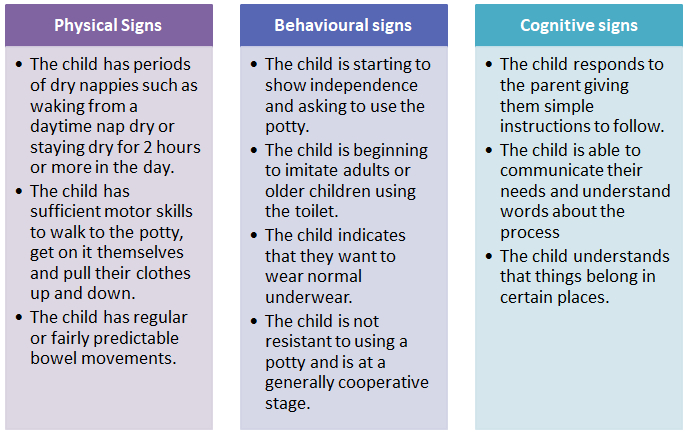The recommended age to start potty training a child can vary depending on a number of factors but the average age is between two and three years. Sometimes parents may feel pressurised if other parents have potty trained their children from a much younger age, however there is a difference between 'toilet timing' and 'toilet training'. It may be possible to place a baby or toddler onto a potty at the right time following their normal routine, however a child under 18 months is unable to control their bladder and bowel as the sphincter muscles required to do so will not have developed at that point. Toilet or potty training is very different as this involves the child being able recognise their own body signals and get themselves onto a potty to use it.
The success of potty training hinges not only on a child's physical readiness but also their emotional and cognitive readiness. Identifying these physical, behavioural and cognitive signs will help determine if the child is ready.

It is advisable to wait for the child to demonstrate the majority of these signs before beginning the process as there is a greater likelihood of success. Even if the child is showing all of the signs it is still important to encourage rather than force a toddler to use a potty. If, for example, the child is going through a resistant 'no' or 'won't' phase a parent may wish to delay the process until this stage has ended.
If the child is not ready, the parent will still benefit from preparing for when the time is right. They can do this by taking the child into the toilet with them so they can observe, or perhaps reading stories together that involve using the toilet or potty.
It may be that the child has shown physical, behavioral and cognitive signs of being ready; however a parent may wish to also take into account the external factors that can impact on success. Avoiding any difficult or transitional phases such as the child starting nursery, being unwell, moving house or when a new sibling arrives are recommended. Success is more likely if it is easier for the parent to manage the process. Some parents choose to wait until summer when the weather is warmer, as with fewer clothes it is easier for the child to dress and undress themselves and they will spend more time outdoors making accidents easier to clear up. However, this consideration will depend on when during the year the child initially begins to demonstrate signs of readiness and only if a short delay is anticipated.
